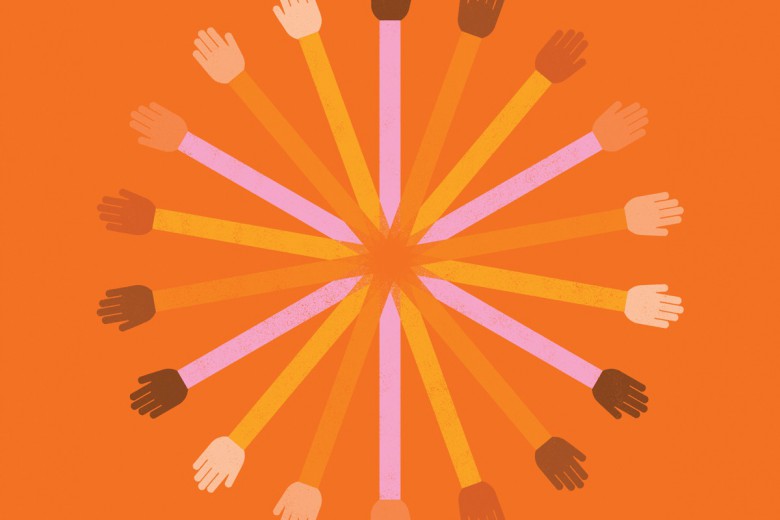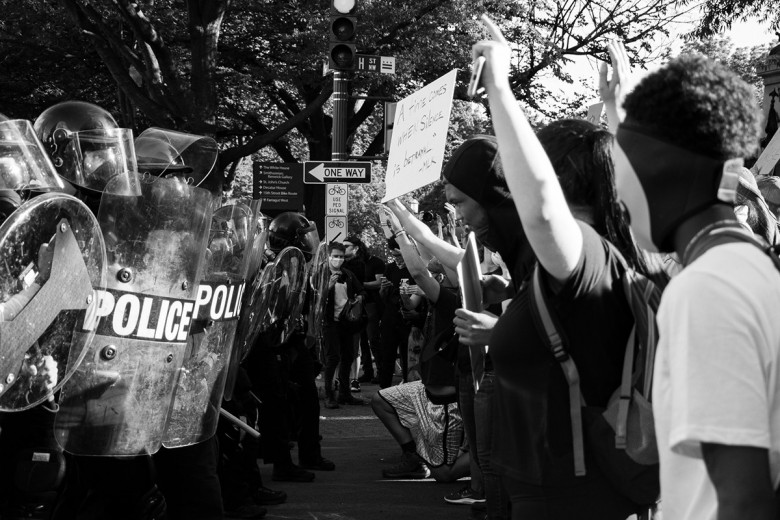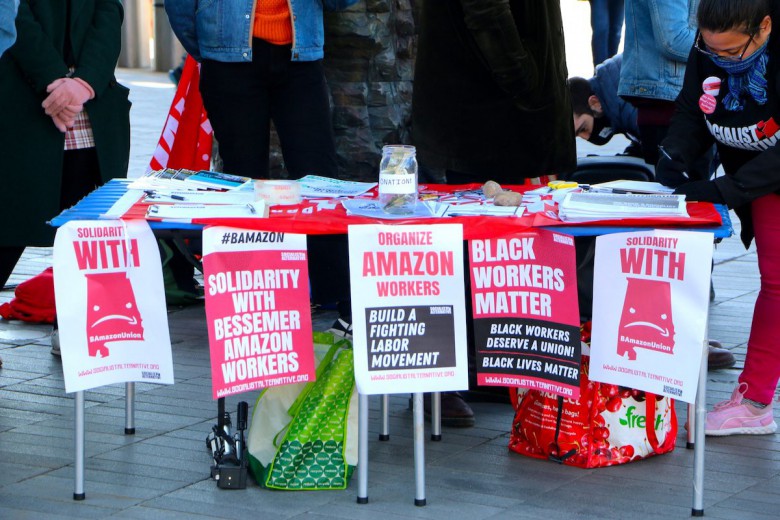Over the last decade, I’ve travelled around the U.S. and Canada, talking with people involved in a variety of radical movements. Along the way, I’ve heard stories, ideas, worries, and questions about struggles for social transformation – a kind of collective brilliance that I’m eager to share widely. While I’ve encountered many themes across these conversations, one that has struck me is “the long haul,” a concept that came up in conversations with community organizers in Boston, Indigenous solidarity activists in Winnipeg, labour organizers in Los Angeles, and youth activists in Vancouver, among other places. It clearly resonates.
The basic idea of the long haul is this: building large-scale movements capable of fundamentally transforming society requires people to work together, with persistence, over decades and across generations. Those of us committed to creating radical change can and should fight for victories along the way, and as the late historian Howard Zinn regularly asserted, we can anticipate that there will be many unexpected turns, both positive and negative. But there will be few certainties, many setbacks, and no infallible formulas for action. Although it’s not easy, the only way forward is to stick around in struggle.
Based on this conviction, I began giving short presentations called “For the Long Haul” while on tour in 2014–2015 with my book Another Politics. Very consistently, these presentations catalyzed discussions among groups of activists. I’d like to describe my own journey into these discussions and share some of the questions and insights I’ve come across.
A long view
I grew up a white guy in a middle-class suburb of Anchorage, Alaska, on traditional Dena’ina territory. My relatively privileged life didn’t offer me many resources for making sense of the col-onialism, poverty, gendered violence, militarism, and ecological destruction that I encountered in Alaska. But while attending a public alternative school in the early 1990s, my anarchist and socialist teachers presented more critical ways of understanding the world. As the U.S. government was carrying out the first Gulf War, my friends and I were taking classes in developing nations studies, the civil rights movement, and women’s literature. We read radical history and theory voraciously, discussed politics constantly, and started organizing around environmentalism, feminism, labour solidarity, and democracy at our school.
We also began to see ourselves as participants in long lineages of struggles for justice and dignity. While learning about past movements was an important part of this for me, even more crucial was building relationships with elder radicals who had been active in those movements. One of these people was Ruth Sheridan, whom I first met when she came to speak in my Grade 8 labour history class. Sheridan, then in her 70s (and now in her 90s), is a lifelong anarchist who has participated in the Industrial Workers of the World, the women’s liberation movement, the Central American solidarity movement, waves of antiwar organizing, and much more. She has a keen mind, a hearty laugh, an indomitable spirit, and a fierce love for people.
Neither Sheridan nor the other older radicals in her circle are famous. Their names will probably never appear in history books and their individual contributions will be mostly forgotten, except by their close comrades and loved ones. They knew this, and yet they kept going, sustaining lives in struggle through major wars, mass movements, state repression, political transitions, new upsurges, and crushing defeats. They were in for the long haul; they carried, as Spanish anarchist José Buenaventura Durruti Dumange used to say, a new world in their hearts. Their steadfastness profoundly shaped my political consciousness.
One of the most important things I learned from Sheridan and others like her is that sticking around in struggle is easier when we cultivate “a long view,” an expression that suggests two things. First, things have been – and can be – different. After all, most of the social relations and structures that we currently take for granted – race, prisons, the nuclear family, waged work, fossil fuels, and much more – are comparatively recent developments in human history; they can be challenged and changed. Second, as a migrant justice activist from Tucson pointed out to me, a long view involves viscerally experiencing ourselves as links in an intergenerational chain of struggle; we build on the sacrifices and contributions of those who came before us, and we make our own sacrifices and contributions for those who will come next.
Challenges
But, let’s be honest: holding a long view is helpful but not sufficient for staying involved for the long haul. Our movements face consistent challenges that are shaped by how power is presently organized and administered. The ruling relations in our society generate immense wealth and power for a very small proportion of the population while creating differentiated misery among the vast majority and ecological destruction across the planet. This social structure affects the challenges we confront while building resilient movements – including precarious work, fragmented communities, state violence, and displacement. Overcoming these sorts of challenges requires organizing on a scale that most of us are really only beginning to imagine.
Other challenges for sustaining long-haul efforts are more directly rooted in movement cultures. These are ways in which we, as activists and organizers, trip ourselves up through our habitual patterns of acting and relating. While these challenges grow out of ruling relations, those of us involved in movements bear real responsibilities for sustaining them. I’ll focus on two such challenges here, both of which have come up regularly in my discussions with people in the U.S. and Canada.
The first is the tendency for movements to replicate, however unconsciously, oppressive values and practices from the society in which we live. This is nothing new; many who have come before us (notably, radical women of colour feminists in the 1960s and 1970s) have observed this tendency. Still, it’s worth repeating the insight: even as we fight hierarchies based on gender, ability, race, sexuality, class, and other ruling relations, these hierarchies have shaped us and we frequently participate in reproducing them. As New York prison abolitionist Pilar Maschi said to me, “We’re trying to break down the system, and it lies in all of us.”
We can see the replication of the systems of oppression in the types of people who most often step confidently into leadership roles in movements (often men, usually white and able-bodied, frequently university-educated), the ongoing reality of sexual assault among activists, and the movement activities that regularly get the most social recognition (writing, public speaking, and high-risk direct action). This is also visible in the exclusionary assumptions that sometimes get built into campaigns – as, for instance, when immigrant rights efforts have used the slogan, “we’re not criminals,” which leaves out anyone who has ever been entangled in the criminal justice system.
This is a significant challenge. Oppressive values and practices don’t just mar our liberatory aspirations. They also undermine our effectiveness: they spread hurt and distrust, corrode alliance-building, impede visionary strategy-making, damage and sometimes destroy organizations, and hold people back from stepping into their full capabilities. And though I understand why many radicals have become jaded about all of this, I side with those who say we can do better.
A key part of this shift is recognizing that no one is untouched by power relations. As feminist theorist and activist Alexis Shotwell argues in her forthcoming book, Against Purity: Living Ethically in Compromised Times, “We need to shape better practices of responsibility and memory for our placement in relation to the past, our implication in the present, and our potential creation of different futures.” This means working with commitment and intention to shift oppressive values and practices – and reduce their everyday harms – without pretending to be untainted by them. It means that, even with the best of intentions, our efforts will be imperfect and contradictory. Building long-haul movements, I believe, requires patience, humility, and a determination to struggle with this challenge without easy answers or quick resolution.
The second challenge is the tendency toward suspicion, rivalry, and dismissal in activist circles. A longtime radical at an event in Boston described this as “a climate of contempt on the left.” And though rarely written about, this is something many have experienced. Indeed, whenever this topic comes up in discussions, I’ve found it quickly evokes head nods and horror stories about takedowns on social media, organizational territorialism, activist social status hierarchies, sectarian posturing, and a general atmosphere of radical self-righteousness.
Kim Smith and Nick Montgomery, two graduate student activists I met in Victoria, helped me to better understand this tendency. Building on queer theorist Eve Sedgwick’s use of the concept, they propose that “paranoid reading” has become the dominant mode of engagement on the radical left. This is a way of relating with people, ideas, and activities by looking primarily for their failures and limitations; it’s about criticizing first and asking questions later, if at all. Smith and Montgomery suggest that “a paranoid stance tends towards constant vigilance, so that there can be no bad surprises. But the upshot of this is that there can’t be any surprises at all when we’re paranoid, because we close off our capacity to be curious, open, and vulnerable.” While this stance is justified and useful at times, it becomes problematic when it’s the dominant approach because “it tends to force out other ways of relating,” Smith and Montgomery say. “Kindness, curiosity, gratitude, and other ways of relating can come to seem naive or counter-productive when paranoia is the reflex.”
Ways of relating based on objectification, competition, and exclusion are deeply ingrained in how power works in this society. It’s not surprising that these corrosive ways of relating seep into movements – thriving, in fact, in the last few decades of weakness and defeat for the left. In this period when radical activist culture has become closely connected to universities, it’s also not surprising that “paranoid reading,” as a pervasive mode in academia, has had such influence on the left.
Still, we have a responsibility to reach toward other, more affirmative ways of being and acting. As Montreal anti-prison organizer Helen Hudson pointed out to me, “struggle can be a really humanizing experience.” That is, when people come together to fight collectively, we can feel our own humanity and the humanity of others in profound ways. People are more likely to stick around, I believe, when movements offer opportunities to experience kindness, curiosity, gratitude, and care as part of effective collective action to change the world.
Lessons
There are things we can do right now to build long-haul movements. Across North America, thousands of people are deeply, earnestly engaged in transformative initiatives and are developing valuable knowledge about what they’re doing. Activists and organizers are crafting a variety of innovative approaches for sustaining struggles, but we frequently lack the time and mechanisms for sharing what we’re learning across places and movements. In one small effort to remedy this, I’ll highlight two lessons that I’ve encountered repeatedly.
The first lesson is that long-haul movements need organizations – intentionally structured groups of people with shared goals and activities. This is something I’ve heard from many people, but Rachel Herzing, an Oakland-based prison industrial complex abolitionist and co-founder of Critical Resistance, makes this point particularly well. During a conversation in Berkeley, Herzing said, “Re-orienting toward organization and talking about the variety of formations it can take – whether that’s a network, an organization, a coalition, etc. – really is important to me in terms of thinking about the long term. So, what is possible to build not only as a collection of individuals but when you put an organizational form to work in terms of organizing?” Organizations, at their best, can become much more than “collections of individuals”: they can generate collective power, hold memory and vision, and steadily build, even during movement downturns.
I recognize that this point may be controversial. In some parts of the anti-authoritarian left especially, I’ve encountered reticence toward developing anything more than small and/or short-term groups and projects. I have some sympathy for this. Too often on the left, “building organizations” actually means erecting party or party-like structures that tend to be top-down, male-dominated, obsessed with toeing a “political line,” instrumental in how they treat people, and vanguardist in how they relate with popular struggles. But with care and intention, I think we can avoid that long-standing rut. As Herzing suggested, let’s explore a variety of forms. If we want to grow and coordinate long-haul movements, we need resilient, bottom-up organizations through which people can, together, develop liberatory visions, make plans, take action, learn, be accountable, and care for and defend one another.
Thankfully, activists and organizers are already engaged in some valuable organizational experiments. These include multi-tendency left organizations such as Solidarity Halifax, grassroots coalitional efforts such as the Southern Movement Assembly in the U.S. South, radical worker centres such as Montreal’s Immigrant Workers Centre, collectively run non-profits such as the Sylvia Rivera Law Project in New York City, democratic membership organizations such as the Coalition of Immokalee Workers in south Florida, networks of movement-based collectives such as No One Is Illegal in Canada, working-class self-defence organizations such as the Seattle Solidarity Network, and bottom-up labour unions such as the Chicago Teachers Union. We can learn a lot from the experiences of all of these models while we also experiment further.
The second lesson is that long-haul movements must be intergenerational. Sustained efforts to transform the world need contributions and continuity from people throughout their lives. Rahula Janowski, an anti-racist organizer with the Catalyst Project in San Francisco, has consistently articulated this point. In a 2007 article for Left Turn, she writes, “mono-generational movements that do not include people in all stages of life will neither move nor win. We need communities that are strong, that can withstand difficult times and challenges, and that can nurture and support its members to continue the work. A community of resistance that is multi-generational will have a continuum of memory, will carry lessons from one generation to the next, and will be a base for strong multi-generational movements.”
We still have a ways to go before we have movement cultures in which most people stick around as they grow older and, particularly, as they have children. In radical activist scenes especially, people tend to “age out” by their 30s, if not earlier. But lately, I’ve been excited to encounter increasingly more people who are serious about intergenerational movement-building. Doing this well, they suggest, will require growing in at least a couple of directions.
One is about opening space for kids and families. It’s no coincidence that some of the most influential advocates for intergenerational movements (including Victoria Law, China Martens, and Cynthia Dewi Oka) are mothers. They bring sharp perspectives about the ways in which many radical initiatives, mostly unintentionally, exclude children and the adults responsible for them. They also highlight the benefits of welcoming families in movement efforts: more intentionality in caregiving activities, deepened relationship-building, new opportunities for organizing, more play and creativity, and greater participation and leadership from the women and gender non-conforming people who overwhelmingly tend to care for kids.
Some of the most tangible efforts to take up this direction of work are city-based radical child-care collectives, many of which loosely coordinate through the Intergalactic Conspiracy of Childcare Collectives. Closely collaborating with grassroots organizations, these collectives provide child care for parents involved in political activities while developing broader kid-friendly movement culture.
Another direction for intergenerational growth is opening space for people beyond their early adulthoods and especially in their later years. One thing that has repeatedly struck me as I’ve travelled is how rarely younger and older radicals, particularly in bigger cities, interact. (Bear in mind that, in youth-oriented activist time, “older” can be as little as five years’ age difference.) This kind of generational segregation is tremendously debilitating for movements. It deprives older people of the energy and insight of younger people, and it cuts younger people off from the endurance and knowledge of older people.
What can we do to change this? Building organizations, as I mentioned earlier, is key. We could really use more structures that hold and nourish people as they age to ensure that, as they encounter new life demands, they remain involved in political activities. Disability justice also offers a crucial starting point for building intergenerational movements. As organizers in numerous places have told me, this partly means creating organizations and campaigns with multiple points of entry and engagement, rather than simplistically assuming that people are either available for everything or are not serious activists. Across life stages and abilities, people experience a variety of limits on what – and how much – they can do, and they also have a beautifully wide array of contributions to make. We need our structures and culture to recognize, invite, and facilitate their involvement.
We can also learn from activists and organizers who have already been cultivating cross-generational relationships. In Vancouver, for instance, No One Is Illegal conducted and filmed interviews with older radicals, making the videos available through its Inheriting Resistance project. I’ve found that people involved in supporting political prisoners tend to be especially deliberate about this kind of relationship-building. They understand that many dedicated revolutionaries of earlier generations have been imprisoned or murdered, and thus are significantly cut off from younger generations. In the words of Helen Hudson, “the state actively tries to separate generations of organizers.” This analysis is partly what led Hudson and others to work on the Certain Days: Freedom for Political Prisoners Calendar, a yearly cross-generational collaborative project between younger activists and older imprisoned radicals. These types of initiatives point toward the vibrant intergenerational movements that, with intentionality and creativity, we can grow.
Building in a movement moment
There is no question in my mind that we are in a movement moment. Black Lives Matter is blossoming alongside a growing movement against the prison industrial complex, and there are still significant reverberations from the Occupy movement experience. Idle No More has re-energized anti-colonial struggles, and the Quebec student movement has set a benchmark for large-scale, combative struggles against austerity. Across the continent, migrant justice and climate justice organizing are especially on the rise, and activists involved in both are increasingly bringing direct action and radical vision. And there is much more happening, too. Although movements still are quite weak, these are encouraging openings.
Stephanie Guilloud, an organizer with Project South in Atlanta, summed this up during a discussion in Brooklyn: “so many people are moving into motion right now.” Consequently, she said, “a big question that faces longtime organizers is, how do we support large numbers of people moving into motion and sustain that activation over time?” At least in part, this is a question of the long haul: how do we develop movement cultures and struct-ures that can last beyond the high points of mobilizations, maintain momentum, and provide ways for people to stay involved in lifelong struggle? We can answer this by reckoning with challenges and limitations, especially ones we generate ourselves, and building on the rich experiences and insights that our movements possess. This, I believe, is how we can turn a moment of upsurge into a sustained confrontation with dominant institutions and relations, and realize the new world in so many hearts.







